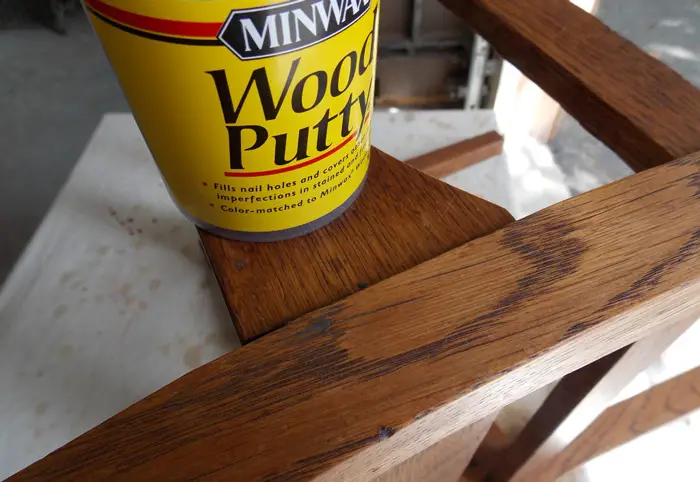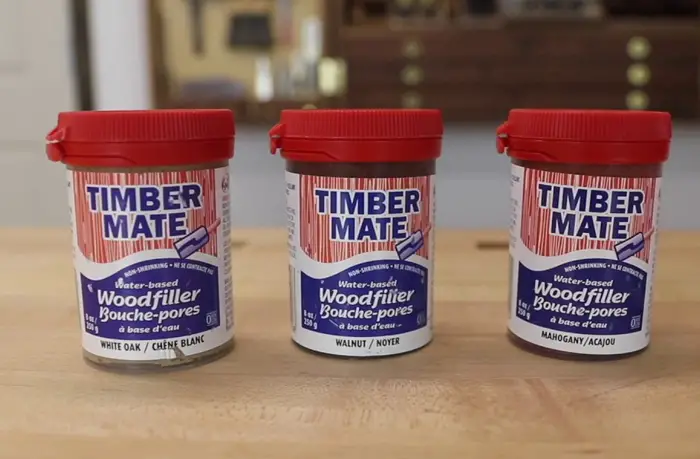How To Hide Wood Filler After Staining – 6 Effective Methods
A wood filler comes in handy when you want to hide imperfections like nail holes or cracks in wood before staining it. Unfortunately, most wood fillers don’t absorb stains well, leaving unsightly marks.
This leads us to the question: how to hide wood filler after staining? You can apply an extra thin coat of gel stain over the wood filler. Alternatively, you can sand down the wood filler, use a wood stain marker, or apply a wood-tone colored wax. You could also apply putty over the filler or use inlays from the same wood.
But wait, there’s more! So, read on to discover more about wood filler not taking stain.
Why Hide Wood Filler After Staining?
During staining, there is always the possibility of the wood filler not absorbing the stain well. Therefore, the fillers may show through the wood after staining, creating a significant visual contrast or an undesirable appearance. So, hiding the wood filler helps reduce the disparity.

In addition, hiding the filler helps enhance the natural look of the stained wood. This is because the exposed filler usually gives the wood a patched-up appearance. More importantly, it helps you achieve a more professional-looking finish.
How to Hide Wood Filler After Staining?
After staining, there are several effective ways to hide the wood filler. Let’s check them out.

1. Apply an Additional Layer of Gel Stain
One way to hide the unsightly wood filler after you are done with staining is to use a gel stain. This is because, unlike liquid dye, gel stain on wood filler doesn’t entirely seep in.
So, you just need to apply a thin layer of your gel stain over the wood filler using a cloth or brush. Then, wipe off any excess immediately and let it dry. And for the best results, you should use a dark-colored gel stain.
2. Sand Down The Wood Filler
Another method of hiding the wood filler is to sand it down lightly. Here are step-by-step instructions on how to do it.
- Step 1: After staining, get a 220-grit sandpaper or a sanding machine. Then, sand the areas where the wood filler is noticeable.
- Step 2: Wipe the area clean using a towel to remove any sawdust. Let the wood dry.
- Step 3: Re-stain the sanded parts using a stain that matches the original wood color.
- Step 4: Let the stain sit on the surface for a while. Then, use a clean cloth to remove the excess dye.
3. Use a Wood Stain Marker

A wood stain marker is excellent for quick and easy touch-ups of any nicks and scratches on wood furniture. Therefore, you can use it to hide wood fillers after staining. The marker works like a pen, making it effortless to apply the stain directly over the wood filler. Here is how the method works:
- Step 1: Sand the wood filler using 220-grit sandpaper until it becomes flush with the rest of the wood.
- Step 2: Choose a stain marker that matches your wood stain to get the perfect blend for your wood.
- Step 3: Shake the marker well and remove the cap.
- Step 4: Next, apply a thick layer of the stain over the wood filler and let it sit for a few seconds.
- Step 5: Then, dry the excess stain using a paper towel or any absorbent material like cloth. Don’t rub.
- Step 6: Take the paper towel and lightly buff it in circles. This is to ensure the stain is not all over the wood surface.
- Step 7: Close the cap tightly and store the stain marker on its side.
4. Applying Wax
After staining, you can apply another environmentally-friendly coat of paste wax to reduce the wood filler blemishes. You simply add a light coat of wax before applying your wood sealer. And for the best results, you should choose a wood-tone colored wax.
5. Use Wood Putty

Most wood putties are typically a mixture of oil-based and plastic solvents. Therefore, they don’t harden like wood filler, making them suitable for hiding filler after staining. To use the putty:
- Step 1: Get a putty knife and a color-matched wood putty to ensure it blends with your stained wood.
- Step 2: Using your putty knife, apply the wood putty over the wood filler. You can gently press the putty into the filler.
- Step 3: Smooth over the surface and let the putty dry.
- Step 4: Once dry, sand down the putty until it becomes flush with the rest of the wood. However, this is only if the putty is a blend of wood chips and glue. This is because putty containing plastic and oil-based solvents cannot be sanded.
6. Use Inlays from The Same Wood
Another option for hiding the wood filler is to cut inlays from pieces of the same wood. Make sure the inlays have matching grain. Then, glue the pieces over the sections with the wood filler. Unless with close inspection, no one should tell your wood has a patch.
Tips To Prevent Wood Filler From Showing After Staining
Sometimes, it is possible to prevent the wood filler from showing through the wood after staining. Below, we will discuss the tips to help you with this.

Mix Wood Stain and Wood Filler
Before applying the wood filler, mix it with a small amount of wood stain. This helps change the wood filler’s color, ensuring it matches the stain color you apply on your wood.
Use The Correct Wood Filler
The correct wood filler depends on the type of wood stain you use. So, if using a water-based stain, the filler should also be water-based instead of oil-based. This helps ensure the dye is evenly absorbed by the wood filler.

Choose a Wood Filler Color That Matches the Wood
Just like wood stains, wood fillers also come in many colors. Therefore, it is advisable to select a shade that closely blends with the color of the wood you want to stain. This is how to make wood filler look like wood.
Use Darker Stain Color
If using a dark-colored stain, the best wood filler for staining should be lighter in color. This can help blend the filler with the entire wood. Unlike light-colored wood stains, darker stains are less translucent. They also stain deeper, covering up any imperfections from wood fillers.

Add Sawdust to the Filler
Alternatively, you can mix small amounts of sawdust with the wood filler before applying it. This is to help blend the wood filler’s color and texture of the wood.
If you’re looking to achieve a flawless finish by hiding wood filler after staining and need insights, our guide on what to do with wood chips from stump grinding might offer creative solutions for repurposing wood waste. Additionally, if you’re dealing with scratches on wood floors and need tips on fixing them, our article on how to fix scratches on wood floors could provide helpful advice. We understand the importance of achieving the best finishes and addressing specific application techniques, and our comprehensive resources are designed to help you navigate and make informed choices for your woodworking projects.FAQs
In this section, we will respond to some frequently asked questions about how to hide wood filler after staining.
Q: Can wood conditioner hide wood filler after staining?
No. You can only use a wood conditioner before staining and after applying the wood filler. This is because the conditioner is formulated to help the wood absorb the stain evenly, which can help hide the wood filler.
Q: Why does staining over wood filler give blotchy results?
This can happen depending on the type of wood filler you use, stain color, and the drying time. Also, uneven application and not using a filler color that matches your wood color can prevent the wood filler from showing through after staining.
Q: Can you use wood stain to hide wood filler after staining?
Yes, you can. However, it is recommended to use gel stain instead. This is because unlike wood stain, which penetrates deep into the wood, gel stain sits on top of the wood. As such, it can easily hide the wood filler.
Bottom Line
If you don’t like the sight of wood filler after staining, there are many ways to hide it to achieve professional results. For example, you could sand down the filler or apply an extra layer of gel stain over the filler. Alternatively, you could use wood putty, paste wax, or a wood stain marker.
The important thing is knowing how to implement each method to avoid blotchy results. With that said, many tips also help you avoid the wood filler from showing after staining. One way to do this is by mixing your wood stain with the filler and using a darker-colored stain. Using the correct wood filler can also help.




